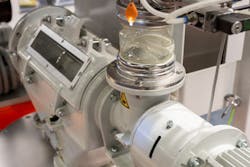Over the years, your plant has added several extrusion machines. Initially, the plant had one small extruder; plastic pellets were added to the hopper by manually dumping them in there from 40 lb bags stored near the extruder. This didn’t scale, and late last spring when yet another extruder, this one far larger than any of the others, was being added, a decision was made to add a feed system.
Now a truck pulls up and a transfer hose is connected so that the pellets are transferred to a large outdoor tank. There’s another transfer mechanism to pull pellets into the distribution piping inside the building. Controllers for each extruder take pellets as needed from this system.
This system worked fine, even through most of the winter. But then the motor for the truck-to-tank transfer system failed and was replaced. Shortly thereafter, the motor for the tank-to-building transfer system failed and was replaced.
Your boss wants you to determine why these motors failed. What are some possible causes?
Solution
When there’s a problem with a system, your first step is to check the power supply. These motors are outdoors; does that mean they are far from their supply panel? Far enough for a significant voltage drop? Measure the supply voltage at each motor. Low voltage causes motors to run hot; even if it’s cold outside, the heat could be too much.
A bigger concern with voltage, however, is voltage imbalance. Measure the voltage on each phase (to ground) and then calculate the maximum voltage imbalance. Motors are particularly sensitive to this; combined with other factors, even an “acceptable” amount of voltage imbalance may be too much for these motors in this application.
Any time a system is located outdoors with temperature variations, condensation can be a problem. With the plastic pellets, it is possible that condensation turned to ice. This could be a factor for the tank-to-building transfer motor, but it is not a factor for the truck-to-tank transfer motor.
Each motor, however, could have condensation inside its housing. If you still have access to the failed motors, have a motor repair shop conduct a forensic examination with an eye to identifying signs of moisture-related tracking or other damage. If the shop says moisture was present, then install a heater in each of the replacement motors.
Another concern here is what happens to the static electricity generated by all those pellets? Without a sufficient, reliable path to the equipment grounding conductor, that static electricity will discharge through the motor bearings and may also damage the motor insulation, rotor, or stator. Install a static collector on the intake hose (from the truck) and onto any other nonconductive equipment through which the pellets pass. Then bond those to the equipment grounding conductor. The motor housings, any enclosures, and any metallic raceway also must be bonded.
If any raceway is nonmetallic, it must include a bonding conductor sized per Article 250, Part V.
A conscientious electrician might conclude that it also wouldn’t hurt to drive a ground rod so as to make sure that static is no longer an issue. This, however, won’t help in any way because it’s not providing a low impedance path to the equipment grounding conductor.
About the Author

Mark Lamendola
Mark is an expert in maintenance management, having racked up an impressive track record during his time working in the field. He also has extensive knowledge of, and practical expertise with, the National Electrical Code (NEC). Through his consulting business, he provides articles and training materials on electrical topics, specializing in making difficult subjects easy to understand and focusing on the practical aspects of electrical work.
Prior to starting his own business, Mark served as the Technical Editor on EC&M for six years, worked three years in nuclear maintenance, six years as a contract project engineer/project manager, three years as a systems engineer, and three years in plant maintenance management.
Mark earned an AAS degree from Rock Valley College, a BSEET from Columbia Pacific University, and an MBA from Lake Erie College. He’s also completed several related certifications over the years and even was formerly licensed as a Master Electrician. He is a Senior Member of the IEEE and past Chairman of the Kansas City Chapters of both the IEEE and the IEEE Computer Society. Mark also served as the program director for, a board member of, and webmaster of, the Midwest Chapter of the 7x24 Exchange. He has also held memberships with the following organizations: NETA, NFPA, International Association of Webmasters, and Institute of Certified Professional Managers.
